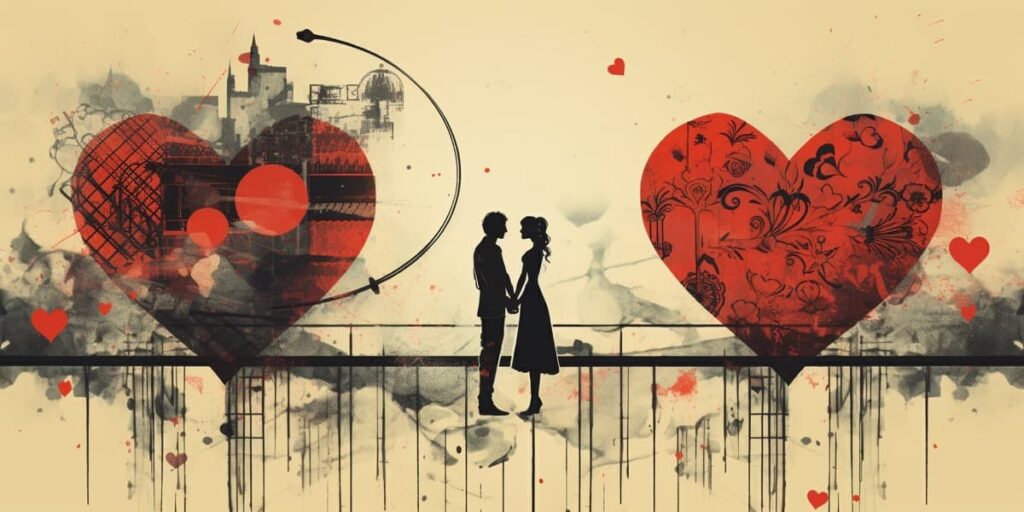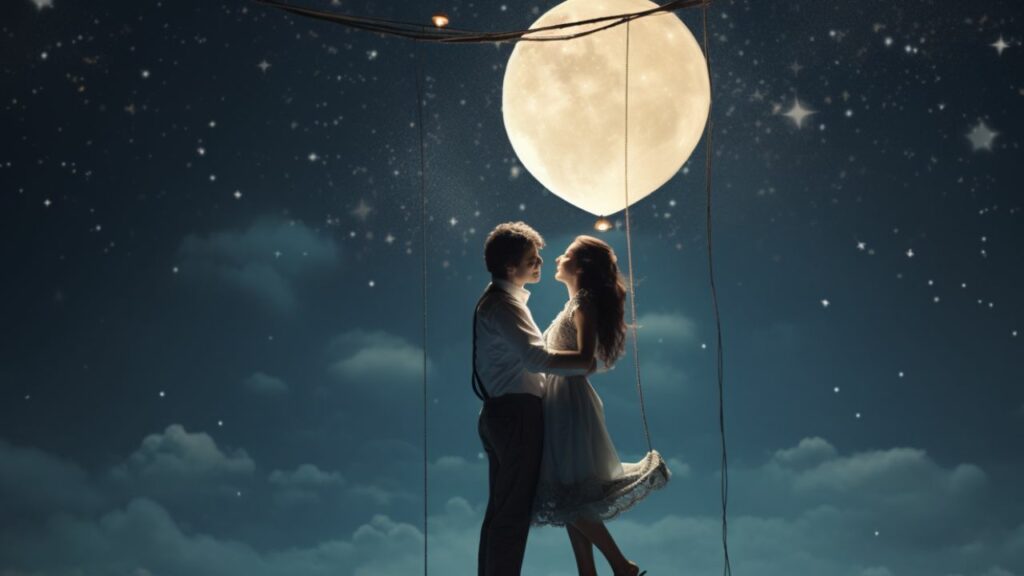I’ve always been intrigued by the power of symbols. They serve as a bridge, connecting our thoughts and emotions to the tangible world. Among all, love symbols hold a special place in our hearts and culture. These seemingly simple designs carry profound meanings, telling stories of affection that transcend time and language barriers.
Speaking about love can often be complex and nuanced. That’s where love symbols come into play. They offer us an expressive way to communicate this universal feeling without uttering a single word. From heart-shaped icons to infinity signs, each symbol carries its own interpretation of love that’s steeped in history and cultural significance.
Throughout the ages, various cultures have used different symbols to represent love – each with its own unique story behind it. Unraveling these tales offers fascinating insights into how our ancestors perceived and expressed this powerful emotion. It also reveals how certain symbols have evolved over time yet continue to resonate with people today.
Understanding Symbols for Love
Symbols have always played a significant role in expressing emotions that are often too profound to be captured by mere words. When it comes to love, there’s an entire array of symbols that span across cultures and timelines, each with its unique interpretation and significance.
Take, for instance, the heart symbol. It’s universally recognized as a representation of love. Though you might think it’s a recent phenomenon fueled by Valentine’s Day cards and emojis, this symbol has been around since the Middle Ages! The shape we’re familiar with today is believed to have been inspired by silphium plant seeds used as birth control in ancient Libya.
Then there’s the rose – a classic emblem of romantic love. Specifically, red roses are traditionally associated with passion and deep affection. The Greeks attributed roses to Aphrodite, the goddess of love. In modern times, giving someone a bouquet of red roses is often seen as an expression of deep romantic feelings.
Symbols aren’t just limited to tangible objects either; they can also be found in nature or even within our own behaviors! Swans provide such an example: these graceful creatures mate for life and are often pictured in pairs, their necks forming a heart shape – another potent symbol for enduring love.
The act of giving gifts itself could be seen as symbolic: when I offer someone chocolates or jewelry out of affection; I’m not just handing over items but expressing my sentiment through them.
Here are some common symbols traditionally linked with love:
- Heart
- Red Rose
- Dove
- Swan
- Cupid
It’s fascinating how these symbols hold so much significance and help us articulate our feelings better than words ever could. After all, isn’t it true what they say? Actions (or symbols) speak louder than words!
Historical Significance of Love Symbols
Delving into the fascinating realm of love symbols, it’s quite intriguing to see how they’ve evolved and been embraced across different cultures. For centuries, these emblems have held a special place in art, literature, rituals, and everyday life.
One of the most recognized symbols for love worldwide is undoubtedly the heart. Although it’s uncertain when this symbol was first associated with love, some theories suggest its origin dates back to ancient times. The Greeks linked the concept of love with Eros (also known as Cupid), often represented by a heart pierced by an arrow.
Doves are another widespread symbol coming from both Greek mythology and biblical reference. Aphrodite, the Greek goddess of love, had a dove as her sacred animal while in Christian symbolism; doves represent pure and divine love.
In Eastern culture too there’s evidence of unique symbols that signify love. In China for instance, the double happiness sign (‘囍’) is popularly used at weddings indicating mutual love and respect between couples.
Now let’s not forget roses! Universally admired for their beauty and fragrance – roses particularly red ones – have become synonymous with passionate affection since Victorian times when flowers were used as coded messages.
The historical significance of these symbols isn’t just about representing romantic sentiments but also conveying deeper emotions like commitment, sacrifice and tenacity in relationships:
- Heart: Symbolizes deep emotional connection
- Dove: Represents purity or divine nature
- Double Happiness Sign: Shows mutual respect & joy
- Rose: Stands for passion or desire
Each emblem carries profound historical roots subtly reminding us that despite cultural differences we all share similar aspirations when it comes to matters of the heart.
Popular Cultural Symbols for Love
Love, it’s a universal language that unites us all. Yet, we’ve come up with myriad ways to symbolize and represent this powerful emotion in our cultures. Let’s take a look at some of the most popular cultural symbols for love.
In the world of flora, certain plants have been long associated with love. The red rose is perhaps the most recognized symbol of romantic love worldwide, thanks to its prominent role in Western culture. But it’s not just roses! Tulips are another flower often linked with love, specifically perfect or deep love.
Now let’s move from flowers to animals – doves and swans are two birds commonly used as symbols for love. Doves symbolize peace and purity alongside their message of love; they’re often seen being released during weddings as a sign of eternal commitment. Swans on the other hand represent fidelity – have you ever noticed how they form a heart shape when their beaks touch?
Symbols aren’t just limited to natural elements though, there are numerous man-made objects that signify love too! The heart shape is one you’ll recognize instantly; it has become synonymous with affection and passion across many different cultures.
Finally, let’s not forget about those precious gems – diamonds have been marketed as a representation of everlasting love thanks largely to De Beers’ “A Diamond Is Forever” campaign launched back in 1947.
So there we go – these are just a handful of examples showing how diverse our expressions of symbolic love can be! It truly goes to show that even though we may express it differently, the essence of what we’re communicating is remarkably similar: an intense feeling of deep affection.
Love Symbols in Different Religions
When it comes to expressing love, I’ve found that symbols are often used as a universal language. These signs of affection aren’t limited to hearts or Cupid’s arrows; they stretch far and wide across different religions and cultures.
In Christianity, for example, the cross is considered a powerful symbol of sacrificial love. It’s representative of Jesus Christ’s selfless act of laying down his life for mankind. This profound emblem reminds us that love is more than just a feeling – it’s about actions and sacrifices.
Let’s not forget Hinduism either. The lotus flower holds great significance here, embodying divine beauty and purity. It blooms amidst muddy water, symbolizing our potential to rise above challenging circumstances with grace and dignity – just like how we navigate through trials in love.
Judaism offers another perspective with its enduring symbol: the Star of David. Interpreted by many as an emblem of divine protection, it serves as a reminder that love protects us from harm and guides our path forward.
Meanwhile, in Buddhism, the endless knot (or eternal knot) stands out prominently. With its intricately connected lines forming a closed loop, it signifies the interconnectedness of all things in the universe – including love which binds everything together harmoniously.
And then there’s Islam where the crescent moon and star serve as potent symbols not only for faith but also for guidance through darkness — much like how love can guide us during difficult times.
Truly exploring these varied religious emblems opens up new perspectives on how we perceive and express our feelings towards each other. And isn’t this what makes understanding love so fascinating?
Symbols for Love in Art and Literature
Art and literature have always been a rich tapestry where symbols of love flourish. Let’s dive into this fascinating world, shall we?
In art, one of the most universally recognized symbols for love is the heart. It’s as prevalent in ancient cave paintings as it is on today’s emoji-laden text messages! Another potent symbol is the dove. Predominantly seen in Renaissance art, doves symbolize fidelity – a critical aspect of love.
- The Heart
- The Dove
Now let’s turn our attention to roses. They’re more than just beautiful flowers; they’ve long been associated with deep affection and admiration. Red roses in particular represent romantic love, making them a popular choice for Valentine’s day.
- The Rose
Shifting gears to literature now, Shakespeare famously used light and darkness to depict love in Romeo and Juliet. Here, light embodies the power of their young love amidst the ‘dark’ hatred between their families.
Another literary classic that uses symbolic imagery is Jane Austen’s Pride and Prejudice. Elizabeth Bennet’s change of feelings towards Mr Darcy can be seen through her changing perception of his estate – Pemberley – which represents Mr Darcy himself.
- Light & Darkness (Romeo & Juliet)
- Pemberley Estate (Pride & Prejudice)
Lastly, who could forget about Cupid? This mythical figure from Roman mythology – equipped with his famous bow and arrow – has become synonymous with falling hopelessly in love.
These examples barely scratch the surface but I hope it gives you an idea of how diverse yet universal symbols for love can be across different forms of expression.
How to Use Love Symbols Effectively
Using love symbols can be a powerful way to express emotions that words fail to articulate. But it’s crucial to know how to use them effectively. Here I’ll share some tips on using these poignant illustrations with success.
Firstly, context matters – always consider the setting and recipient before sharing a love symbol. For instance, giving someone a red rose on Valentine’s Day is a classic gesture of romantic affection. Yet handing out roses in a business meeting would likely seem out of place.
Secondly, remember that the meaning behind certain symbols can vary across different cultures. A love symbol familiar in one country might have an entirely different connotation elsewhere. Therefore, it’s important to do your homework before incorporating any into your communications or gifts.
Thirdly, don’t overdo it – subtlety often works best when dealing with matters of the heart. It’s tempting to shower our loved ones with all possible symbols of endearment but they may lose their significance if used too frequently or excessively.
Finally, personalize your love symbols where possible. Customizing these emblems according to your unique relationship adds depth and authenticity which generic versions may lack.
Here are some popular symbols for love:
- Heart: Universally recognized as the ultimate symbol of love.
- Rose: Often associated with deep affection or desire.
- Dove: Symbolizes peacefulness and loyalty in relationships.
- Cupid: Represents romantic attraction or falling in love.
To sum up, effective use of love symbols requires tactfulness and insight into cultural nuances and personal preferences. Used properly, they can become precious tokens that encapsulate profound feelings between people.
The Science Behind Symbolism and Love Perception
Ever wondered why certain symbols stir up feelings of love? Let’s delve deep into the fascinating world of symbolism and its connection with our perception of love.
The science behind this phenomenon is pretty intriguing. Our brains are wired to make associations. When we repeatedly see a particular symbol associated with love – like a heart, for example – our brain begins to associate that symbol with the feeling of love itself.
In fact, it’s not just about visual symbols. Sounds, smells or even tastes can evoke feelings of love if they’re consistently paired with loving experiences in our past. A song you danced to on your first date, the perfume your partner wore, or the taste of your grandmother’s homemade cookies – these can all be potent symbols of love in their own right.
A study by Semino et al., 2014 found that people often use metaphors when talking about love. These metaphors can serve as symbolic representations that help us understand and express complex emotions like love.
Here is a table showing some common metaphoric expressions for ‘love’ used in their research:
| Metaphoric Expression | Meaning |
|---|---|
| Falling in Love | The process where one starts experiencing love |
| Love is War | The conflicts experienced during a romantic relationship |
| Love is Madness | Expressing intense emotional upheaval related to being in love |
This extensive use of metaphorical language shows how deeply symbolism influences how we perceive and communicate about love.
Neurologically speaking, when we encounter these symbols or hear metaphorical expressions, specific areas in our brain linked to emotion light up. Known as the limbic system, this part includes structures such as hippocampus and amygdala which play essential roles in memory formation and emotional responses respectively.
To sum it up:
- Symbolism plays a key role in influencing our perception and expression of emotions including love.
- Our brains are wired to associate symbols with emotions based on our past experiences.
- Metaphorical language serves as a form of symbolic representation in communicating about love.
So, the next time you see a heart-shaped balloon or hear “your song” on the radio, remember, it’s all down to the fascinating science of symbolism and your brain’s wonderful ability to link symbols with love.
Conclusion: The Universal Language of Love Symbols
Love, a complex and profound emotion, is universally expressed. But it’s the symbols for love that truly bridge gaps, transcending language barriers and cultural differences. Throughout this article, I’ve explored numerous symbols representing love across time and cultures.
From the timeless heart symbol to the enchanting rose or the captivating eternity knot – every symbol holds a deep meaning rooted in history and human emotion. These symbols play an instrumental role in conveying a sentiment that’s sometimes too overwhelming for words alone.
- The Heart: Universally recognized as the prime symbol of love.
- Rose: A classic image embodying passion, beauty, and affection.
- Eternity Knot: Signifying never-ending love.
To sum up my exploration into these fascinating tokens of affection:
- Symbols are powerful tools aiding us in expressing our deepest emotions.
- Love symbols have historical roots dating back thousands of years.
- They transcend language barriers, making them universally understood.
Remember though – while these symbols help express feelings, they don’t substitute genuine actions or heartfelt words. So whether you’re etching an infinity sign onto a charm or sending roses to your beloved, make sure your actions mirror your symbolic gestures.
In essence, using these symbols can enhance communication between individuals or even groups who understand their significance. They’re more than just simple drawings; they carry with them centuries of human experiences and shared understanding about one of life’s most potent emotions – love.
Embrace these universal signs for what they represent – enduring expressions of that indescribable feeling we all cherish deeply within us – love!



